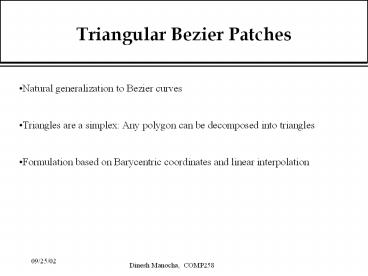Triangular Bezier Patches - PowerPoint PPT Presentation
Triangular Bezier Patches
Triangles are a simplex: Any polygon can be decomposed into triangles ... Given a triangle with vertices A, B, C and a fourth point P, ... – PowerPoint PPT presentation
Title: Triangular Bezier Patches
1
Triangular Bezier Patches
- Natural generalization to Bezier curves
- Triangles are a simplex Any polygon can be
decomposed into triangles - Formulation based on Barycentric coordinates and
linear interpolation
2
Barycentric Coordinates
- Given a triangle with vertices A, B, C and a
fourth point P, - P can be expressed as a barycentric combination
of A, B, and C - P u A v B w C,
- and u v w 1
- The coefficients (u,v,w) are called barycentric
coordinates of P with respect to A, B, C - Given A,B,C and P, the barycentric coordinates
can be computed as
3
Barycentric Coordinates
- Barycentric coordinates are affinely invariant,
i.e. an affine map or tranformations preserves
the barycentric coordinates - If a point is outside the triangle one of the
Barycentric coordinate may be negative - For all points inside the triangle, the
Barycentric coordinates are non-negative
4
de Casteljau Algorithm for Triangular Patches
Given a triangular patch of degree n with
control points ( bi bijk), where i ijk and
i i j k e1 (1,0,0) e2 (0,1,0)
e3 (0,0,1) The de Casteljau evaluation
algorithm is where r 1,..,n and i n
r, and u (u,v,w) are the barycentric
coordinates of a point, where the function is
evaluated. and is the point with
parameter value u on the triangular Bezier
patch.
5
Properties of Triangular Patches
- Affine invariance
- Convex hull property
- Invariance under affine parameter transformation
- Boundary curves are Bezier curves of degree n
6
Bernstein polynomials
- The Bernstein polynomials are defined as
- , where i n
- and a triangular patch can be written in terms of
Bernstein polynomials as
PowerShow.com is a leading presentation sharing website. It has millions of presentations already uploaded and available with 1,000s more being uploaded by its users every day. Whatever your area of interest, here you’ll be able to find and view presentations you’ll love and possibly download. And, best of all, it is completely free and easy to use.
You might even have a presentation you’d like to share with others. If so, just upload it to PowerShow.com. We’ll convert it to an HTML5 slideshow that includes all the media types you’ve already added: audio, video, music, pictures, animations and transition effects. Then you can share it with your target audience as well as PowerShow.com’s millions of monthly visitors. And, again, it’s all free.
About the Developers
PowerShow.com is brought to you by CrystalGraphics, the award-winning developer and market-leading publisher of rich-media enhancement products for presentations. Our product offerings include millions of PowerPoint templates, diagrams, animated 3D characters and more.































